United States presidential election, 1852
| | |||||||||||||||||||||||||||||||||||||||||||||||||||
| |||||||||||||||||||||||||||||||||||||||||||||||||||
| |||||||||||||||||||||||||||||||||||||||||||||||||||
|
| |||||||||||||||||||||||||||||||||||||||||||||||||||
| Presidential election results map. Blue denotes states won by Pierce/King, Orange denotes those won by Scott/Graham. Numbers indicate the number of electoral votes allotted to each state. | |||||||||||||||||||||||||||||||||||||||||||||||||||
| |||||||||||||||||||||||||||||||||||||||||||||||||||
The United States presidential election of 1852 was the 17th quadrennial presidential election, held on Tuesday, November 2, 1852. It bore important similarities to the election of 1844. Once again, the incumbent president was a Whig who had succeeded to the presidency upon the death of his war-hero predecessor. In this case, it was Millard Fillmore who followed General Zachary Taylor. The Whig party passed over the incumbent for nomination—casting aside Fillmore in favor of General Winfield Scott. The Democrats nominated a "dark horse" candidate, this time Franklin Pierce. The Whigs again campaigned on the obscurity of the Democratic candidate, and again, the strategy failed.
Pierce and his running mate William R. King went on to win what was at the time one of the nation's largest electoral victories, defeating Scott and his vice-presidential nominee, William Alexander Graham of North Carolina, 254 electoral votes to 42. After the 1852 election, the Whig Party quickly collapsed, and the members of the declining party failed to nominate a candidate for the next presidential race due to the uproar over the Kansas-Nebraska Act. This is the last presidential election in which the Whig Party participated. In 1854, the Whig Party effectively collapsed as a national political force, largely because of tensions over slavery. It was soon replaced as the Democratic Party's primary opposition by the new Republican Party. In spite of the appearance of Democratic triumph, no presidential candidate from the Democratic party would again win both a majority of the popular and electoral vote until 1932, when Franklin D. Roosevelt won a larger majority against Republican Herbert Hoover.
Nominations
The 1852 presidential election conventions of the parties are considered below in order of the party's popular vote.
Democratic Party nomination
Democratic candidates:
- Franklin Pierce, Former Senator from New Hampshire
- Lewis Cass, Senator from Michigan
- Joseph Lane, Delegate from Oregon
- Sam Houston, Senator from Texas
- Levi Woodbury, Associate Justice from New Hampshire
- William O. Butler, Former Representative and General from Kentucky
- Daniel S. Dickinson, Senator from New York
- Philip Allen, Governor of Rhode Island
- Henry Dodge, Senator from Wisconsin
Democratic Party candidates gallery
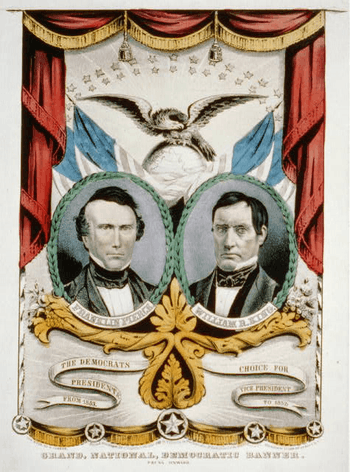
-

Associate Justice Levi Woodbury of New Hampshire (Died Before Convention)
-

Former Congressmen and General William O. Butler of Kentucky
As Democrats convened in Baltimore in June 1852, four major candidates vied for the nomination: Lewis Cass of Michigan, the nominee in 1848, who had the backing of northerners in support of the Compromise of 1850; James Buchanan of Pennsylvania, popular in the South as well as in his home state; Stephen A. Douglas of Illinois, candidate of the expansionists and the railroad interests; and William L. Marcy of New York, whose strength was centered in his home state. Throughout the balloting, numerous favorite son candidates received a few votes.
Cass led on the first 19 ballots, with Buchanan second, and Douglas and Marcy exchanging third and fourth places. Buchanan took the lead on the 20th ballot and retained it on each of the next nine tallies. Douglas managed a narrow lead on the 30th and 31st ballots. Cass then recaptured first place through the 44th ballot. Marcy carried the next four ballots. Franklin Pierce of New Hampshire, a former Congressman and Senator, did not get on the board until the 35th ballot, when the Virginia delegation brought him forward as a compromise choice. He consolidated his support in subsequent voting and was nominated nearly unanimously on the 49th ballot.[2]
In a peace gesture to the Buchanan wing of the party, Pierce's supporters allowed Buchanan's allies to fill the second position, knowing that they would select Alabama Senator William R. King. On the second ballot, with only minor opposition, King finally obtained the Democratic vice-presidential nomination. During the ensuing campaign, King's tuberculosis, which he believed he had contracted while in Paris, France, denied him the active behind-the-scenes role that he might otherwise have played, although he worked hard to assure his region's voters that New Hampshire's Pierce was a "northern man with southern principles." King died little after his inauguration on April 18, 1853.
Whig Party nomination
Whig candidates:
- Winfield Scott, General from New Jersey
- Millard Fillmore, President of the United States from New York
- Daniel Webster, Secretary of State from Massachusetts
- Edward Bates, Former Representative from Missouri
- Rufus Choate, former Senator from Massachusetts
- John J. Crittenden, Attorney General from Kentucky
Whig Party candidates gallery

The 1852 Whig National Convention, held in Baltimore, Maryland, was bitterly divided. Supporters of President Fillmore pointed to the successful Compromise of 1850 and the failure of a nascent secession movement in the Southern states in 1850–1851. The northern Whigs believed that the Compromise of 1850 favored the slaveholding South over the North. Northern Whigs favored heroic Mexican-American War General Winfield Scott of New Jersey. Scott had earned the nickname of "Old Fuss and Feathers" in the military due to his insistence on appearance and discipline, and while respected, was also seen by the people as somewhat foppish. A deadlock occurred because most New England delegates supported Daniel Webster. On the first ballot, Fillmore received all delegate votes from the South save four, but only received 18 northern delegate votes. The vote was 133 for Fillmore, 131 for Scott, and 29 for Webster. Scott was nominated on the 53rd ballot by a margin of 159–112 (with 21 for Webster), again with a highly sectional vote; Scott won the North by a 142–11 vote (with 21 for Webster) while Fillmore won the South by a margin of 101–17.
William Alexander Graham was chosen as the vice-presidential nominee. 1852 would be the penultimate time the Whig Party would nominate a candidate for president. Within the decade, the party fell apart and ceased to exist, principally due to regional divisions caused by the slavery issue.
Free Soil Party nomination
Free Soil candidates:
- Winfield Scott, General from New Jersey
Candidates Gallery
The Free Soil Party was still the strongest third party in 1852, though many of the "Barnburners" who supported it in 1848 had returned to the Democratic Party. The second Free Soil National Convention assembled in the Masonic Hall in Pittsburgh, Pennsylvania. New Hampshire Senator John P. Hale was nominated for president with 192 delegate votes (16 votes were cast for a smattering of candidates). George Washington Julian of Indiana was nominated for vice-president over Samuel Lewis of Ohio and Joshua R. Giddings of Ohio.
Union Party nomination
The Union party was formed in 1851, an offshoot of the Whig party in several Southern states, including Georgia. As the 1852 presidential election approached, Union party leaders decided to wait and see who was nominated by the two major parties. The movement to nominate Daniel Webster as a third-party candidate began in earnest following the Whig Convention, largely driven by those who had been strenuously opposed to Winfield Scott's nomination, among them Alexander Stephens, Robert Toombs, and George Curtis. While Webster was against what he perceived as a "revolt" from the Whig Party and preferred not to be nominated, he let Americans vote for him should the party chose to nominate him.
The Union Party held its Georgia state convention on August 7, 1852 and nominated Webster for president and Charles J. Jenkins of Georgia for vice-president. A formal convention was held at Faneuil Hall in Boston, Massachusetts on September 15, affirming the nominations made at the state convention in Georgia and rejecting Winfield Scott as nothing more than a military figure. The Webster/Jenkins ticket received nationwide support, particularly among Southern Whigs, but also in Massachusetts and New York, but it was largely perceived by many as nothing more than getting voteerz who would, in different circumstances support, Scott.
Webster had no real chance of winning the election, but even the new Know-Nothing party endorsed Webster, even nominating him without his own permission. Unfortunately, Webster died before the election of a cerebral hemorrhage on October 24, 1852.
Native American (Know-Nothing) Party nomination
Around the mid-1840s, nativists were present in various New York politics, under the American Republican Party. The American Republican party was formed in 1843 in major opposition to immigration and Catholicism. In 1845, the party changed its name to the Native American Party. Their opponents nicknamed them the "Know Nothings" and the party liked the name and it became the nickname of the party after that until it collapsed in 1860. In 1852, the original candidate planned by the Native American Party was Daniel Webster, the nominee of the Union party as well as Secretary of State. They nominated Webster without his own permission, with George C. Washington (grandnephew of George Washington) as his running mate. Webster died of natural causes a little more than a week before the election, and the Know Nothings quickly replaced Webster by nominating Jacob Broom as president and replaced Washington with Reynell Coates. With Webster collecting a few thousand votes, Broom received too few, and lost the election. In the future, former president Millard Fillmore would be their candidate in 1856.
Southern Rights Party nomination
Southern Rights candidate:
- George Troup, Former Senator from Georgia
Candidates gallery
The Southern Rights Party was an offshoot of the Democratic party in several Southern states which advocated secession from the Union, electing a number of Congressmen and holding referendums on secession in a number of southern states (none of which were successful).
It was unclear in early 1852 if the Party would contest the presidential election. When the Alabama state convention was held in early March, only nine counties were represented. The party decided to see who was nominated by the two major national parties and support one of them if possible. When Georgia held its state convention, it acted as the state Democratic Party and sent delegates to the national convention.
After the Democratic National Convention, the Party was not sure that it wanted to support Franklin Pierce, the Democratic nominee. Alabama held a state convention from July 13 to the 15th and discussed at length the options of running a separate ticket or supporting Pierce. The convention was unable to arrive at a decision, deciding to appoint a committee to review the positions of Scott and Pierce with the option of calling a “national” convention if the two major party candidates appeared deficient. The committee took its time reviewing the positions of Pierce and Scott, finally deciding on August 25 to call a convention for a Southern Rights Party ticket.
The convention assembled in Montgomery, Alabama, with 62 delegates being present a committee to recommend a ticket being appointed while listening to speeches in the interim. The committee eventually recommended former Senator George Troup of Georgia for President, and former Governor John Quitman of Mississippi for the Vice President; they were unanimously nominated.
The two nominees accepted their nominations soon after the convention, which was held rather late in the season. Troup stated in his letter, dated September 27 and printed in the New York Times on October 16, that he had planned to vote for Pierce and had always wholeheartedly supported William R.D. King. He indicated in the letter that he preferred to decline the honor, as he was rather ill at the time and feared that he would die before the election. The Party's executive committee edited the letter to excise those portions which indicated that Troup preferred to decline, a fact which was revealed after the election.
Liberty Party nomination
The Liberty Party had ceased to become a significant political force after most of its members joined the Free Soil Party in 1848. Nonetheless, some of those who rejected the fusion strategy held a Liberty Party National Convention in Buffalo, New York. There were few delegates present, so a ticket was recommended and a later convention called. The Convention recommended Gerrit Smith of New York for president and Charles Durkee of Wisconsin for vice-president. A second convention was held in Syracuse, New York, in early September 1852, but it too failed to draw enough delegates to select a nominee. Yet a third convention gathered in Syracuse later that month and nominated William Goodell of New York for president and S.M. Bell of Virginia for vice-president.
General election
Fall Campaign
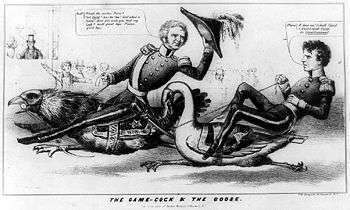
The Whigs' platform was almost indistinguishable from that of the Democrats, reducing the campaign to a contest between the personalities of the two candidates. The lack of clearcut issues between the two parties helped drive voter turnout down to its lowest level since 1836. The decline was further exacerbated by Scott's antislavery reputation, which decimated the Southern Whig vote at the same time as the pro-slavery Whig platform undermined the Northern Whig vote. Ater the Compromise of 1850 was passed, many of the southern Whig Party members broke with the party's key figure, Henry Clay.[3]
Finally, Scott's status as a war hero was somewhat offset by the fact that Pierce was himself a Mexican-American War brigadier general.
Shortly before the election, Union Party candidate Daniel Webster died, causing many Union state parties to remove their slates of electors. The Union ticket appeared on the ballot in Georgia and Massachusetts, however.
Results

When American voters went to the polls, Pierce won in a landslide; Scott won only the states of Kentucky, Tennessee, Massachusetts, and Vermont, while the Free Soil vote collapsed to less than half of what Martin Van Buren had earned in the previous election, with the party taking no states. The fact that Daniel Webster received a substantial share of the vote in Georgia and Massachusetts, even though he was dead, shows how disenchanted voters were with the two main candidates.
As a result of the devastating defeat and the growing tensions within the party between pro-slavery Southerners and anti-slavery Northerners, the Whig Party quickly fell apart after the 1852 election and ceased to exist. Some Southern Whigs would join the Democratic Party, and many Northern Whigs would help to form the new Republican Party in 1854.
Some Whigs in both sections would support the so-called "Know-Nothing" party in the 1856 presidential election. Similarly, the Free Soil Party rapidly fell away into obscurity after the election, and the remaining members mostly opted to join the former Northern Whigs in forming the Republic Party.
The Southern Rights Party effectively collapsed following the election, attaining only five percent of the vote in Alabama, and a few hundred in its nominees home state of Georgia. It would elect a number of Congressmen in 1853, but they would shortly after join the Democratic Party upon taking their seats in Congress.
| Presidential candidate | Party | Home state | Popular vote(a) | Electoral vote |
Running mate | |||
|---|---|---|---|---|---|---|---|---|
| Count | Pct | Vice-presidential candidate | Home state | Elect. vote | ||||
| Franklin Pierce | Democratic | New Hampshire | 1,607,510 | 50.8% | 254 | William R. King | Alabama | 254 |
| Winfield Scott | Whig | New Jersey | 1,386,942 | 43.9% | 42 | William Alexander Graham | North Carolina | 42 |
| John P. Hale | Free Soil | New Hampshire | 155,210 | 4.9% | 0 | George Washington Julian | Indiana | 0 |
| Daniel Webster(b) | Union (c) | Massachusetts | 6,994 | 0.2% | 0 | Charles J. Jenkins | Georgia | 0 |
| Jacob Broom | Native American | Pennsylvania | 2,566 | 0.1% | 0 | Reynell Coates | New Jersey | 0 |
| George Troup | Southern Rights | Georgia | 2,331 | 0.1% | 0 | John A. Quitman | Mississippi | 0 |
| Other | 277 | 0.0% | — | Other | — | |||
| Total | 3,161,830 | 100% | 296 | 296 | ||||
| Needed to win | 149 | 149 | ||||||
Source (Popular Vote): Leip, David. "1852 Presidential Election Results". Dave Leip's Atlas of U.S. Presidential Elections. Retrieved July 27, 2005.
Source (Electoral Vote): "Electoral College Box Scores 1789–1996". National Archives and Records Administration. Retrieved July 31, 2005.(a) The popular vote figures exclude South Carolina where the Electors were chosen by the state legislature rather than by popular vote.
(b)Daniel Webster died on October 24, 1852, one week before the election. However, his name remained on the ballot in Massachusetts and Georgia, and he still managed to poll nearly seven thousand votes. He was also the original candidate of the Native American Party but was replaced on his death by Jacob Broom.
(c)For a detailed discussion of the Union Party formed by Pro-Union Whigs, see Michael F. Holt, The Rise and Fall of the Whig Party: Jacksonian Politics and the Onset of the Civil War (New York: Oxford University Press, 1999), Chapters 19 and 20.
- The leading candidates for Vice President were both born in North Carolina and in fact both attended the University of North Carolina at Chapel Hill, albeit two decades apart. While there, they were members of opposing debate societies: the Dialectic and Philanthropic Societies. Both also served in North Carolina politics: King was a representative from North Carolina before he moved to Alabama, and Graham was a governor of North Carolina.
Results by state
Source: Data from Walter Dean Burnham, Presidential ballots, 1836-1892 (Johns Hopkins University Press, 1955) pp 247-57.
| Franklin Pierce Democratic |
Winfield Scott Whig |
John P. Hale Free Soil |
State Total | |||||||||||||
|---|---|---|---|---|---|---|---|---|---|---|---|---|---|---|---|---|
| State | electoral votes |
# | % | electoral votes |
# | % | electoral votes |
# | % | electoral votes |
# | |||||
| Alabama | 9 | 26,881 | 60.89 | 9 | 15,061 | 34.12 | - | no ballots | 44,147 | AL | ||||||
| Arkansas | 4 | 12,173 | 62.18 | 4 | 7,404 | 37.82 | - | no ballots | 19,577 | AR | ||||||
| California | 4 | 40,721 | 53.02 | 4 | 35,972 | 46.83 | - | no ballots | 76,810 | CA | ||||||
| Connecticut | 6 | 33,249 | 49.79 | 6 | 30,359 | 45.56 | - | 3,161 | 4.73 | - | 66,781 | CT | ||||
| Delaware | 3 | 6,318 | 49.85 | 3 | 6,293 | 49.66 | - | 62 | 0.49 | - | 12,673 | DE | ||||
| Florida | 3 | 4,318 | 60.03 | 3 | 2,875 | 39.97 | - | no ballots | 7,193 | FL | ||||||
| Georgia | 10 | 40,516 | 64.70 | 10 | 16,660 | 26.60 | - | no ballots | 62,626 | GA | ||||||
| Illinois | 11 | 80,378 | 51.87 | 11 | 64,733 | 41.77 | - | 9,863 | 6.36 | - | 154,974 | IL | ||||
| Indiana | 13 | 95,340 | 52.05 | 13 | 80,901 | 44.17 | - | 6,929 | 3.78 | - | 183,170 | IN | ||||
| Iowa | 4 | 17,763 | 50.23 | 4 | 15,856 | 44.84 | - | 1,606 | 4.54 | - | 35,364 | IA | ||||
| Kentucky | 12 | 53,494 | 48.32 | - | 57,428 | 51.44 | 12 | 266 | 0.24 | - | 111,148 | KY | ||||
| Louisiana | 6 | 18,647 | 51.94 | 6 | 17,255 | 48.06 | - | no ballots | 42,873 | LA | ||||||
| Maine | 8 | 41,609 | 50.63 | 8 | 32,543 | 39.60 | - | 8,030 | 9.77 | - | 82,182 | ME | ||||
| Maryland | 8 | 40,022 | 53.28 | 8 | 35,077 | 46.69 | - | 21 | 0.03 | - | 75,120 | MD | ||||
| Massachusetts | 13 | 44,569 | 35.07 | - | 52,683 | 41.45 | 13 | 28,203 | 22.19 | - | 127,103 | MA | ||||
| Michigan | 6 | 41,842 | 50.45 | 6 | 33,860 | 40.83 | - | 7,237 | 8.73 | - | 82,939 | MI | ||||
| Mississippi | 7 | 26,896 | 60.50 | 7 | 17,558 | 39.50 | - | no ballots | 44,454 | MS | ||||||
| Missouri | 9 | 38,817 | 56.42 | 9 | 29,984 | 43.58 | - | no ballots | 68,801 | MO | ||||||
| New Hampshire | 5 | 28,503 | 56.40 | 5 | 15,486 | 30.64 | - | 6,546 | 12.95 | - | 50,535 | NH | ||||
| New Jersey | 7 | 44,305 | 53.24 | 7 | 38,556 | 46.33 | - | 359 | 0.43 | - | 83,220 | NJ | ||||
| New York | 35 | 262,083 | 50.18 | 35 | 234,882 | 44.97 | - | 25,329 | 4.85 | - | 522,294 | NY | ||||
| North Carolina | 10 | 39,778 | 50.43 | 10 | 39,043 | 49.49 | - | no ballots | 78,881 | NC | ||||||
| Ohio | 23 | 168,933 | 47.83 | 23 | 152,523 | 43.18 | - | 31,732 | 8.98 | - | 353,188 | OH | ||||
| Pennsylvania | 27 | 198,562 | 51.20 | 27 | 179,104 | 46.18 | - | 8,495 | 2.19 | - | 387,389 | PA | ||||
| Rhode Island | 4 | 8,735 | 51.37 | 4 | 7,626 | 44.85 | - | 644 | 3.79 | - | 17,005 | RI | ||||
| South Carolina | 8 | no popular vote | 8 | no popular vote | no popular vote | - | SC | |||||||||
| Tennessee | 12 | 56,900 | 49.27 | - | 58,586 | 50.73 | 12 | no ballots | 115,486 | TN | ||||||
| Texas | 4 | 13,552 | 73.07 | 4 | 4,995 | 26.93 | - | no ballots | 18,547 | TX | ||||||
| Vermont | 5 | 13,044 | 29.72 | - | 22,173 | 50.52 | 5 | 8,621 | 19.64 | - | 43,890 | VT | ||||
| Virginia | 15 | 73,872 | 55.71 | 15 | 58,732 | 44.29 | - | no ballots | 132,604 | VA | ||||||
| Wisconsin | 5 | 33,658 | 52.04 | 5 | 22,210 | 34.34 | - | 8,814 | 13.63 | - | 64,682 | WI | ||||
| TOTALS: | 296 | 1,605,943 | 50.83 | 254 | 1,386,418 | 43.88 | 42 | 155,799 | 4.93 | - | 3,159,640 | US | ||||
| TO WIN: | 149 | |||||||||||||||
Electoral college selection
| Method of choosing Electors | State(s) |
|---|---|
| Each Elector appointed by state legislature | South Carolina |
| Each Elector chosen by voters statewide | (all other States) |
See also
- Inauguration of Franklin Pierce
- Second Party System
- United States House of Representatives elections, 1852
- United States Senate elections, 1852
- History of the United States (1849–1865)
References
- ↑ "Voter Turnout in Presidential Elections". The American Presidency Project. UC Santa Barbara.
- ↑ William DeGregorio, The Complete Book of U.S. Presidents, Gramercy 1997
- ↑ Biography of Franklin Pierce
- Books
- Holt, Michael F. The Rise and Fall of the American Whig Party: Jacksonian Politics and the Onset of the Civil War. Oxford University Press, New York, New York: 1999.
- Web sites
- "A Historical Analysis of the Electoral College". The Green Papers. Retrieved September 17, 2005.
External links
- Presidential Election of 1852: A Resource Guide from the Library of Congress
- 1852 popular vote by counties
- 1852 state-by-state popular vote
- Democratic National Convention overview
- Whig National Convention overview
- Native American National Convention overview
- How close was the 1852 election? — Michael Sheppard, Massachusetts Institute of Technology
- Election of 1852 in Counting the Votes
| ||||||||||||||||||||||||||||||
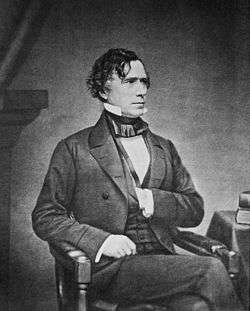



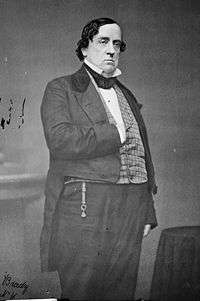
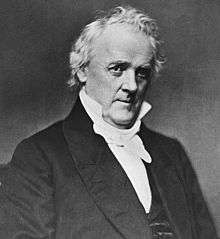



.jpg)






